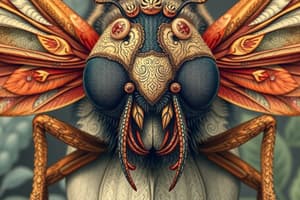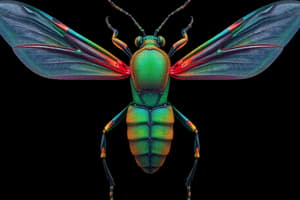Podcast
Questions and Answers
Which of the following best describes the primary composition of an insect's exoskeleton?
Which of the following best describes the primary composition of an insect's exoskeleton?
- Cellulose
- Chitin (correct)
- Calcium carbonate
- Keratin
What is the function of the tracheae in the respiratory system of most insects?
What is the function of the tracheae in the respiratory system of most insects?
- To assist in internal digestion
- To regulate body temperature
- To deliver oxygen to tissues (correct)
- To circulate blood
Which of the following anatomical features is NOT typically used to classify insects?
Which of the following anatomical features is NOT typically used to classify insects?
- Body segmentation
- Mouthparts
- Presence of antennae (correct)
- Wing structure
In which body segment are the legs of an insect located?
In which body segment are the legs of an insect located?
Which order of insects does NOT include members with wings?
Which order of insects does NOT include members with wings?
What type of circulatory system do insects possess?
What type of circulatory system do insects possess?
Which of the following mouthpart adaptations is primarily associated with feeding on liquids?
Which of the following mouthpart adaptations is primarily associated with feeding on liquids?
Which aspect of an insect's nervous system is primarily responsible for controlling movement?
Which aspect of an insect's nervous system is primarily responsible for controlling movement?
Which of the following describes complete metamorphosis in insects?
Which of the following describes complete metamorphosis in insects?
What is a primary ecological role of insects in ecosystems?
What is a primary ecological role of insects in ecosystems?
Which of the following statements about insect population dynamics is true?
Which of the following statements about insect population dynamics is true?
What is one economic importance of insects in agriculture?
What is one economic importance of insects in agriculture?
Which method do insects primarily use for communication?
Which method do insects primarily use for communication?
What are some common threats to insect populations?
What are some common threats to insect populations?
In forensic entomology, what crucial information do insects provide?
In forensic entomology, what crucial information do insects provide?
Which defense mechanism is NOT commonly used by insects?
Which defense mechanism is NOT commonly used by insects?
Flashcards
Metamorphosis
Metamorphosis
The process of an insect transforming from larva to adult, with different types like complete or incomplete metamorphosis.
Incomplete Metamorphosis
Incomplete Metamorphosis
Insects gradually change from egg to nymph to adult, with no distinct pupal stage. Example: Grasshoppers
Complete Metamorphosis
Complete Metamorphosis
Insects undergo major changes through distinct larval, pupal, and adult stages. Example: Butterflies.
Insect Ecology
Insect Ecology
Signup and view all the flashcards
Food Web
Food Web
Signup and view all the flashcards
Insect Economic Importance
Insect Economic Importance
Signup and view all the flashcards
Insect Behavior
Insect Behavior
Signup and view all the flashcards
Threats to Insect Populations
Threats to Insect Populations
Signup and view all the flashcards
Entomology
Entomology
Signup and view all the flashcards
Insect Body Segments
Insect Body Segments
Signup and view all the flashcards
Exoskeleton
Exoskeleton
Signup and view all the flashcards
Insect Mouthparts
Insect Mouthparts
Signup and view all the flashcards
What are the main insect orders?
What are the main insect orders?
Signup and view all the flashcards
Tracheal System
Tracheal System
Signup and view all the flashcards
Insect Circulatory System
Insect Circulatory System
Signup and view all the flashcards
Insect Compound Eyes
Insect Compound Eyes
Signup and view all the flashcards
Study Notes
Introduction to Entomology
- Entomology is the scientific study of insects.
- Insects are a diverse group of arthropod animals characterized by three body segments (head, thorax, and abdomen), three pairs of legs, and usually two pairs of wings.
- They represent the largest group of animals on Earth, with millions of described species.
Insect Morphology
- Exoskeleton: Insects possess a hard, external skeleton made primarily of chitin. This provides protection and support, but restricts growth; insects must molt to grow.
- Body Segments: The body is divided into three segments: head, thorax, and abdomen.
- Head: Bears sensory organs (antennae, eyes), mouthparts (mandibulate, piercing-sucking, etc.) for feeding. Antennae are important for detecting odors and vibrations.
- Thorax: Bears three pairs of legs and usually two pairs of wings (if present); attached to the thorax.
- Abdomen: Contains internal organs, such as the digestive system, reproductive organs, and part of the nervous system.
- Appendages: Legs (walking, jumping, grasping) and wings (flight). Wings are modified from the thoracic exoskeleton.
- Specialized Mouthparts: Insects have diverse mouthpart structures (chewing, piercing-sucking, sponging, siphoning, etc.) adapted to their specific diets.
Insect Classification
- Insects are classified within the phylum Arthropoda.
- Insect classification is based on anatomical features, particularly wing structure and mouthparts.
- Major orders of insects include Coleoptera (beetles), Lepidoptera (butterflies and moths), Diptera (flies), Hymenoptera (ants, bees, wasps), Odonata (dragonflies and damselflies). Many other orders exist.
Insect Physiology
- Respiratory System: Most insects breathe through a system of tracheae, tiny tubes that deliver oxygen directly to their tissues. Some aquatic insects have specialized respiratory structures.
- Circulatory System: An open circulatory system, where hemolymph bathes the tissues directly.
- Digestive System: A complete digestive system with specialized regions for different functions like digestion and absorption.
- Nervous System: A ventral nerve cord with ganglia (clusters of nerve cells) along its length controls the insect's movements.
- Sensory Organs: Eyes (compound eyes and simple eyes--ocelli) for vision; and chemoreceptors (taste and smell) in antennae and other parts for detecting stimuli, including chemicals.
Insect Life Cycle
- Metamorphosis: Insects undergo various types of metamorphosis to develop from larva to adult: complete or incomplete metamorphosis.
- Incomplete Metamorphosis: Gradual changes from egg to nymph to adult.
- Complete Metamorphosis: Major changes through distinct larval, pupal, and adult stages; e.g. egg → larva → pupa → adult.
- Reproduction: Insects have various reproductive strategies, differing according to species; some are parthenogenic (asexual reproduction).
Insect Ecology
- Interactions with other organisms: Insects play crucial roles in ecosystems as herbivores, predators, pollinators, and decomposers.
- Food Web: Insects form a critical link within food webs, transferring energy and nutrients.
- Symbiotic Relationships: Mutualistic and parasitic relationships between insects and other organisms are common.
- Population Dynamics: Factors influencing insect populations include food availability, predators, and environmental conditions.
Insect Economic Importance
- Agriculture: Insects are detrimental to agriculture as pests; some insects are pollinators and natural pest control agents.
- Medicine: Some insects produce valuable compounds (e.g. silk, honey), and some are used in traditional medicine.
- Forests: Insects play significant roles in forest health and dynamics; they can be important pests or beneficial agents in forest ecosystems.
- Forensic Entomology: The study of insects' life cycles, present in association with deceased bodies, helps in forensic investigations.
Insect Behavior
- Communication: Chemicals (pheromones), sounds, visual cues, and touch are used for communication.
- Social Behavior: Many insects exhibit complex social behaviors, including cooperative foraging, defense, reproduction.
- Migration: Insects migrate over long distances to find food, favorable climates, or breeding grounds.
- Defense Mechanisms: Various strategies, like camouflage, mimicry, chemical defenses, stinging, and producing sound, are used for defense against predators.
Insect Conservation
- Threats to insect populations: Habitat loss, pesticide use, and climate change.
- Importance of insect conservation: Insects are essential for ecosystem health and human well-being.
Studying That Suits You
Use AI to generate personalized quizzes and flashcards to suit your learning preferences.




